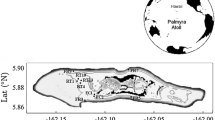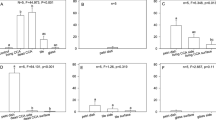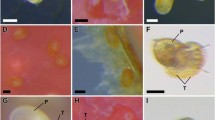Abstract
We designed settlement tiles for coral culture with the aims: (1) to attract and (2) to spatially control settlement and (3) to produce substrate units for further handling in mariculture. Ceramic tiles with vertical (i.e. pyramid tile; truncated pyramid shape, 22.0×22.0, ±1.0 mm, L×W) and horizontal surfaces (i.e. flat tile; 17.0×17.0, ±1.0 mm, L×W) were temporarily arranged chessboard-like in a polystyrene grid. Surfaces of both types were structured with grooves (width and depth 2.0±0.1 mm). Material analysis by ICP and photospectrometry showed negative influences on water chemistry when new tiles were directly used; high contents of heavy metals could be detected depending on the production process. Planulae of Acropora tenuis (16.3±3.1% settlement) preferred to settle in the grooves of pyramid tiles with a density of 0.19±0.03 to 0.44±0.06 settlers cm−2, whereas those of Favia fragum (60.7±13.3% settlement) showed high preferences for the grooves of flat tiles (0.48±0.22 to 1.05±0.44 settlers cm−2). Settlement occurred exclusively on surfaces with a biofilm (turf and crustose coralline algae) and was independent of available substrate surface area, whereas the number of tiles per set-up influenced the density of settlers per unit. Spatial control of settlement was achieved through tile design and arrangement. Tiles with settlers could be easily separated for further use in coral culture.


Similar content being viewed by others
References
Adey WH, Loveland K (1998) Dynamic aquaria: building living ecosystems. Academic, London
Babcock RC, Davies P (1991) Effects of sedimentation on settlement of Acropora millepora. Coral Reefs 9:205–208
Babcock RC, Mundy C (1996) Coral recruitment: consequences of settlement choice for early growth and survivorship in two scleractinians. J Exp Mar Biol Ecol 206:179–201
Epstein N, Bak RPM, Rinkevich B (2001) Strategies for gardening denuded coral reef areas: the applicability of using different types of coral material for reef restoration. Res Ecol 9:1–11
Esquivel I (1983) Short term copper bioessay on planula of the reef coral Pocillopora damicornis. In: Jokiel PL, Richmond RH, Rogers RA (eds) Coral reef population biology. Technical report no. 37, Hawaii Insitute of Marine Biology, Honolulu, pp 465–472
Harrison PL, Wallace CC (1990) Reproduction, dispersal and recruitment of scleractinian corals. In: Dubinsky Z (ed) Ecosystems of the world, vol 25. Coral reefs. Elsevier, Amsterdam, pp 133–207
Harriott VJ, Fisk DA (1987) A comparison of settlement plate types for experiments on the recruitment of scleractinian corals. Mar Ecol Prog Ser 37:201–108
Heyward AJ, Negri AP (1999) Natural inducers for coral larval metamorphosis. Coral Reefs 18:273–279
Hodgson G (1990) Sediment and the settlement of larvae of the reef coral Pocillopora damicornis. Coral Reefs 9:41–43
Holleman AF, Wiberg N (1985) Lehrbuch der anorganischen Chemie, 91st–100th edn. de Gruyter, Berlin
Hunte W, Wittenberg M (1992) Effects of eutrophication and sediment on juvenile corals. Mar Biol 114:625–631
Iwao K, Fujisawa T, Hatta M (2002) A cnidarian neuropeptide of the GLWamide family induces metamorphosis of reef-building corals in the genus Acropora. Coral Reefs 21:127–129
Lewis BL (1974) The settlement behaviour of planulae larvae of the hermatypic coral Favia fragum (Esper). J Exp Mar Biol Ecol 15:165–172
Maida M, Sammarco PW, Coll JC (1995) Effects of soft corals on scleractinian coral recruitment. I. Directional allelopathy and inhibition of settlement. Mar Ecol Prog Ser 121:191–202
Morse ANC, Iwao K, Baba M, Shimoike K, Hayashibara T, Omori M (1996) An ancient chemosensory mechanism brings new life to coral reefs. Biol Bull (Woods Hole) 191:149–154
Mundy CN (2000) An appraisal of methods used in coral recruitment studies. Coral Reefs 19:124–131
Mundy CN, Babcock RC (1998) Role of light intensity and spectral quality in coral settlement: implications for depth-dependent settlement. J Exp Mar Biol Ecol 223:235–255
Negri AP, Webster NS, Hill RT, Heyward AJ (2001) Metamorphosis of broadcast spawning corals in response to bacteria isolated from crustose algae. Mar Ecol Prog Ser 223:121–131
Oren U, Benayahu Y (1997) Transplantation of juvenile corals: a new approach for enhancing colonization of artificial reefs. Mar Biol 127:499–505
Petersen D, Tollrian R (2001) Methods to enhance sexual recruitment for restoration of damaged reefs. Bull Mar Sci 69:989–1000
Soong K, Chen M, Dai CCC, Fan T, Fan JLH (2003) Spatial and temporal variation of coral recruitment in Taiwan. Coral Reefs 22:224–228
Tomascik T (1991) Settlement patterns of Caribbean scleractinian corals on artificial substrata along a eutrophication gradient, Barbados, West Indies. Mar Ecol Prog Ser 77:261–269
Van Moorsel GWNM (1988) Early maximum growth of stony corals (Scleractinia) after settlement on artificial substrata on a Caribbean reef. Mar Ecol Prog Ser 50:127–135
Wilson JR, Harrison PL (1998) Settlement-competency periods of larvae of three species of scleractinian corals. Mar Biol 131:339–345
Acknowledgements
We thank two anonymous reviewers for useful comments on an earlier draft of the manuscript. R. Smits (K&S Decor, Breda, The Netherlands) produced the tiles. M. Hatta provided larvae of Acropora tenuis, D. van Bergen and M. Kuenen supported the collection of Favia fragum. M. Mutapčić carried out photospectrometric analysis and F. Hazewinkel helped with the lay-out of the manuscript. The CITES (Convention on International Trade in Endangered Species of Wild Flora and Fauna) authorities of Japan, Netherlands Antilles and The Netherlands are acknowledged for their permission to transport coral larvae. D.P. was supported by a scholarship program of the German Federal Environmental Foundation (DBU).
Author information
Authors and Affiliations
Corresponding author
Additional information
Communicated by O. Kinne, Oldendorf/Luhe
Rights and permissions
About this article
Cite this article
Petersen, D., Laterveer, M. & Schuhmacher, H. Innovative substrate tiles to spatially control larval settlement in coral culture. Marine Biology 146, 937–942 (2005). https://doi.org/10.1007/s00227-004-1503-7
Received:
Accepted:
Published:
Issue Date:
DOI: https://doi.org/10.1007/s00227-004-1503-7




